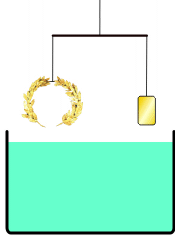Archimedes' principle
Archimedes' principle is named after Archimedes of Syracuse, the first to discover this law. When he did, he ran naked out of his bathtub.[1] Archimedes' principle relates buoyancy to displacement.[2]
Principle

Archimedes' treatise, On floating bodies, proposition five states:
Any floating object displaces its own weight of fluid.
– Archimedes of Syracuse[3]
For more general objects, floating and sunken, and in gases as well as liquids (i.e. a fluid), Archimedes' principle may be stated thus in terms of forces:
Any object, wholly or partially immersed in a fluid, is buoyed up by a force equal to the weight of the fluid displaced by the object.
– Archimedes of Syracuse
For a sunken object, the volume of displaced fluid is the volume of the object, and for a floating object on a liquid, the weight of the displaced liquid is the weight of the object.
Briefly: Buoyancy = weight of displaced fluid.
Gold
To use the principle to tell the difference between gold and another substance, the concept of mass (in practice, weight) must be added.
Apply this formula to a suitably pure piece of gold:
- [math]\displaystyle{ \frac { \text {density of object}} { \text{density of fluid} } = \frac { \text{weight}} { \text{weight} - \text{apparent immersed weight}}\, }[/math]
That gives you the density of the gold sample. The only unknown is the density of the (gold) object; the density of water is 1.
Repeat for the experimental object (non-gold), when you get a different (and usually lesser) density.
Now you can tell what is gold and what is not, and collect your reward from the King of Syracuse. That is why Archimedes shouted "Eureka!"
Second thoughts
We do not actually know if Archimedes used exactly this method. An alternative is to use a scale. On one side put the object to be tested (e.g. the crown). On the other side put gold of equal weight. Immerse the scales. The gold will go down, and the crown up (if it is not gold). That is because, being less dense than gold, it occupies a larger volume and receives more buoyancy.
Other sites and pages
Archimedes' Principle Media
References
- ↑ Acott, Chris (1999). "The diving "Law-ers": A brief resume of their lives". South Pacific Underwater Medicine Society Journal. 29 (1). ISSN 0813-1988. OCLC 16986801. Archived from the original on 2011-04-02. Retrieved 2009-06-13..
- ↑ Displacement here means the water pushed aside by the bottle (or other object).
- ↑ "The works of Archimedes". Cambridge, University Press. 1897. p. 257. Retrieved 11 March 2010.
Any solid lighter than a fluid will, if placed in the fluid, be so far immersed that the weight of the solid will be equal to the weight of the fluid displaced.



